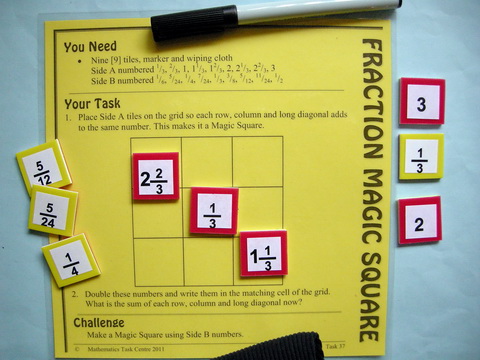
Fraction Magic SquareTask 37 ... Years 4 - 10SummaryStudents usually only experience Magic Squares using whole numbers. This task shows that can also be made using fractions and opens the door to (a) linking with the classic whole number case, and (b) realising that a magic square can be made to total any number at all.
This cameo has a From The Classroom section which shows sample journal work from students in a Year 5 in England. |
Materials
Content
|

IcebergA task is the tip of a learning iceberg. There is always more to a task than is recorded on the card. |
Students who approach this task with the strategy of guess and check, will need further guidance. One question which might produce more effective investigation is: Have you seen a similar problem?If students mention that they have seen whole number versions then that connection can be refined. If the students have not met the classic version, then that is more likely to be the relevant starting point. Once the classic has been experienced two approaches are possible.
The strategy to solve the classic problem has two stages:
The second set of fraction tiles is provided so students can apply what they have learnt to a new (apparently more difficult) case. However, with a little encouragement they can try to create another, and then another, fraction magic square of their own. Soon it becomes reasonable to ask:
|
Whole Class InvestigationTasks are an invitation for two students to work like a mathematician. Tasks can also be modified to become whole class investigations which model how a mathematician works. |
The easiest way to turn this task into a whole class investigation is to ask students to tear a piece of paper into 9 pieces and write on each of them one number from the list you put on the board. The investigation involves making the first fraction magic square, relating this to the classic example and setting up a 'Magic Square Shop' where students undertake to make the pieces of a magic square to form any total given by the customer. There are extensive notes on Maths300. For more ideas and discussion about this investigation, open a new browser tab (or page) and visit Maths300 Lesson 72, Fraction Magic Square. |
Is it in Maths With Attitude?Maths With Attitude is a set of hands-on learning kits available from Years 3-10 which structure the use of tasks and whole class investigations into a week by week planner. |
The Fraction Magic Square task is an integral part of:
The Fraction Magic Square lesson is an integral part of:
|
St. Edmund's Junior School, EnglandMatthew ReamesYear 5 |
Matthew has submitted these sample journal entries about Fraction Magic Square. He comments that Ethan's explanation of why the whole numbers could not share the same rows or columns was "his question, his investigation, his solution!". |
Lucy
|
Ethan

|